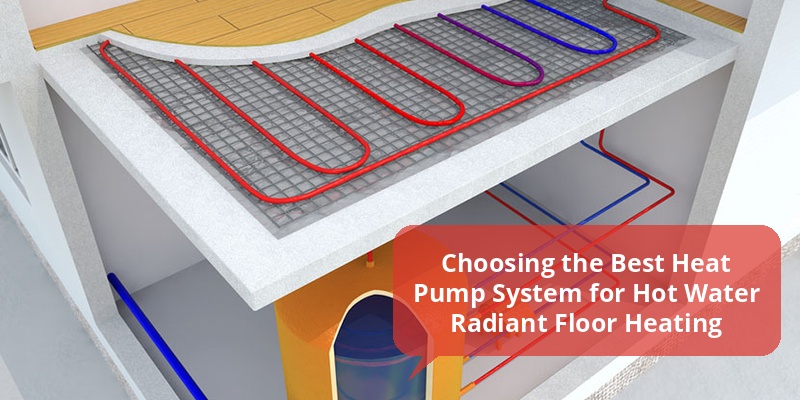Hot water radiant floor heating systems are gaining popularity for their energy efficiency and comfortable warmth. Selecting the appropriate heat pump system is crucial for optimal performance and energy savings. Heat pumps work by transferring heat from one place to another, making them ideal for warming water used in radiant floor heating. This article explores the types of heat pump systems compatible with hot water radiant floor heating and their benefits.
| Heat Pump Type | Compatibility | Efficiency | Ideal Application |
|---|---|---|---|
| Air Source Heat Pump (Water-to-Air) | Moderate | Good | Mild Climates, Retrofit Applications |
| Water Source Heat Pump (Water-to-Water) | High | Very Good | Commercial and Residential with Access to Water Loop |
| Ground Source Heat Pump (Geothermal) | Excellent | Excellent | New Builds, Long-Term Energy Efficiency |
Overview of Hot Water Radiant Floor Heating Systems
A hot water radiant floor heating system operates by circulating warm water through tubing installed beneath the floor surface. This setup provides gentle, even heating throughout the room without the noise and airflow associated with forced-air systems. Such radiant heating improves thermal comfort and energy efficiency by maintaining lower air temperatures while keeping people warm.
These systems typically require a reliable heat source capable of producing warm water at temperatures between 85°F and 140°F. Selecting a heat pump system that consistently delivers this heat range is critical for seamless integration and optimal system performance.
Types of Heat Pump Systems Compatible With Radiant Floor Heating
Air Source Heat Pumps (ASHP)
Air Source Heat Pumps extract heat from the outside air and transfer it to a water loop for floor heating. They are widely used because of their relatively low installation cost and ease of integration with existing systems. ASHPs deliver water at temperatures ranging from 90°F to 130°F, making them suitable for radiant floor heating when climate conditions are moderate.
However, their efficiency can drop in colder climates, which may necessitate supplemental heating during peak winters. Modern cold-climate ASHPs are improving in this regard, but it’s essential to evaluate local temperature patterns before installation.
Water Source Heat Pumps (WSHP)
Water Source Heat Pumps utilize a stable water loop or body of water as a heat exchange medium. These systems produce consistent water temperatures ideal for radiant floor heating applications. Their efficiency is higher than air source systems in many cases because water temperatures fluctuate less than air, allowing better heat transfer.
WSHP systems are well-suited for commercial buildings or residential properties with access to ponds, lakes, or groundwater. Installation costs can be higher than air source units, but operational savings often offset these initial expenses.
Ground Source Heat Pumps (GSHP or Geothermal)
Ground Source Heat Pumps use the constant temperature of the earth to extract heat for hot water. This approach provides the most stable and efficient source of heat for radiant floor systems. GSHPs produce water temperatures consistently between 90°F and 140°F, perfectly matching the needs of hot water radiant floors.
Though geothermal systems involve higher upfront installation costs, they provide significant long-term energy savings and reliability. New construction projects often benefit the most from such systems because of the groundwork required.
Factors to Consider When Choosing a Heat Pump for Radiant Floor Heating
- Climate: Air source heat pumps perform best in mild climates, while geothermal and water source heat pumps handle cold climates more effectively.
- Building Type: Commercial versus residential considerations influence water source versus ground source system feasibility.
- Installation Cost: Budget constraints may favor air source units; however, lifecycle costs should be evaluated.
- Water Temperature Requirements: Radiant floor systems need heat pumps capable of maintaining consistent water temperatures suitable for the flooring type and insulation levels.
- System Integration: Compatibility with existing plumbing and zoning controls affects overall system design.
Benefits of Using Heat Pumps With Hot Water Radiant Floor Heating
Heat pumps paired with radiant floor heating offer several advantages:
- Energy Efficiency: Heat pumps use renewable heat sources, significantly reducing electricity consumption compared to traditional boilers.
- Comfort: Radiant heat provides uniform warmth with less temperature variation.
- Lower Operating Costs: Efficient heat transfer lowers monthly energy bills.
- Environmental Impact: Reduced greenhouse gas emissions compared to fossil fuel heating.
Installation Tips for Heat Pumps and Radiant Floor Systems
Proper installation ensures maximum performance and durability:
- Consult a qualified HVAC professional familiar with radiant heating and heat pump systems.
- Consider a buffer tank to stabilize water temperatures and reduce cycling of the heat pump.
- Use appropriate controls and zoning for efficient temperature management.
- Ensure proper insulation beneath the tubing to minimize heat loss downward.
- Plan system size carefully based on heat load calculations to avoid under- or oversizing.
Comparing Heat Pump Types: Efficiency and Cost Overview
| Heat Pump Type | Installation Cost | Annual Operating Cost | Coefficient of Performance (COP) | Best Climate |
|---|---|---|---|---|
| Air Source Heat Pump | Low to Moderate | Moderate | 3.0 – 3.5 | Mild to Moderate |
| Water Source Heat Pump | Moderate to High | Low to Moderate | 3.5 – 4.5 | Moderate to Cold |
| Ground Source (Geothermal) Heat Pump | High | Low | 4.0 – 5.0 | All Climates |
